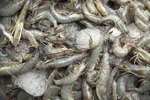
The Maryland blue crab is an olive green crustacean known for its bright blue legs and sweet tasting meat. This crab inhabits all areas of the Chesapeake Bay, frequenting the shallow waters and grass beds in summer while hibernating in deeper trenches for winter. The rather short life span means the blue crab moves quickly through its life cycle.
Reproduction
Mating season occurs from May through October. Males, or jimmies, meet with females, called sooks, in the salty middle waters of the Chesapeake Bay. The male partner carries the female into a protected area while she prepares for her final molt, or the shedding of her hard external shell. The crabs mate after she molts, and the female captures the sperm for later fertilization of the eggs. Afterward, the male continues to carry the female until her outer shell hardens again. This behavior is especially necessary toward successful propagation of the species since the female crab mates only once in her life.
Spawning
While the males seek out another mate, the females migrate to saltier waters of the lower Chesapeake Bay and burrow in the mud. A female will fertilize the eggs and can spawn them multiple times over a period of two to 12 months. A bright orange mass develops by her apron -- the flap on her belly -- containing between 750,000 and 2 million eggs. This sponge will darken in color as the larvae consume the orange yolk. The larvae are released from the mother within two weeks and make their way to the Atlantic ocean.
Zoea and Megalops
The tiny larvae measure less than 1/1000 of an inch during the zoea stage. They look more like shrimp than crabs, with transparent tops featuring a single large eye and tail. The zoea feed on plankton and molt up to eight times over 31 to 49 days as they continue to grow. Zoea then metamorphose into the megalops, a stage that lasts six to 20 days and is the last larval molt. Still tiny, the megalops has a whitish tint but starts to resemble a crab. There is the appearance of legs and front claws, though the animals still sport lobster-like tails.
Juvenile
The juvenile stage marks the crab's return to the upper Chesapeake Bay and its rivers; males will journey farther north than females. Young crabs finally look like adult blue crabs though they are small, measuring barely 1/100 of an inch wide. They will molt several more times before reaching maturity at 12 to 18 months of age. Juveniles can eat small fish, dead organisms and aquatic plants. Once mature, the crabs will add more variety to their diet, including worms, snails, clams, oysters, mussels and even smaller blue crabs.
Death
Due to the high rate of fishing and habitat destruction, blue crabs average a life span of two years, and very few blue crabs live longer than three years. Mature females tend to remain in the spawning area or travel short distances. After mating season, the males return to the creeks, rivers and estuaries of the upper Chesapeake Bay.
References
Resources
Photo Credits
-
Scott Olson/Getty Images News/Getty Images
Writer Bio
Pam Smith has been writing since 2005. In addition to her work for Demand Media, her articles have been published online at CBS Local. She also wrote for the Pennsylvania Center for the Book's Literary Map while earning a Bachelor of Arts degree in English at the Pennsylvania State University. She is currently an editorial assistant for Circulation Research.




